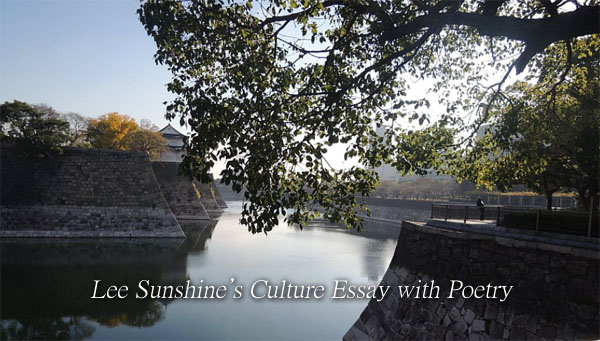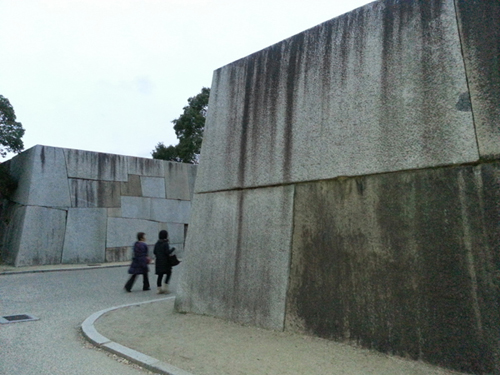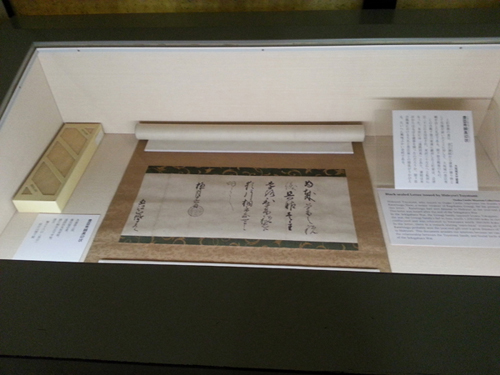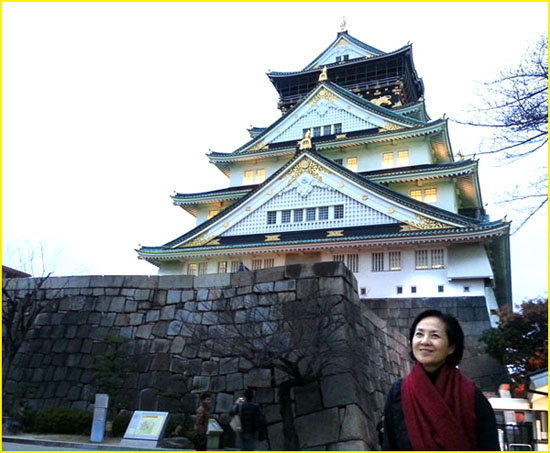
A moat surrounding Osaka Castle Jan 19, 2014
Osaka Castle
Although I frequently visit Kyoto, it has been a while since I’ve visited its neighboring city, Osaka, probably because it is a business town.
Osaka!
It was where I once had breakfast with my father a long time ago.
Before he passed away in 1983, he had been president of the Korea Patent Attorneys Association for 20 years. He used to have me accompany him to international conferences as I speak some English. It was difficult just to get a visa back then. However, most of the big companies in Japan were my father’s clients and he often went there to give lectures on patents and intellectual property rights in Korea.
I only vaguely remember why I was there, but what I do remember vividly is that we stayed at one of the best hotels in Osaka at the time and that we enjoyed breakfast together in the beautiful sunshine.
After having studied at Pyeongyang College of Education, known as a school of poor, brilliant minds, and at a renowned law school in Shingyeong in Manchuria, he passed the bar exam and started his career as chief of the energy section at the Ministry of Commerce & Industry of the US army military government in Seoul. In his thirties, he became chief of the Korean Intellectual Property Office (one of the most underappreciated government official jobs at the time). In 1956, when there was no foundation, he enacted Invention Day and as a pioneer in the field of patent, invention, and intellectual properties he organized the Korea Patent Attorneys Association later on.
Although I vaguely remember him saying that he used to walk twelve kilometers (about 7.5 miles) to school everyday, I could never imagine that he had suffered poverty or went through hardships, because the father I had seen was a man with vision, ability, and the character of a pioneer that creates something out of nothing and because he always seemed large-minded, generous, and relaxed.
At that time over breakfast, as if he was looking back on the past, “I have been able to achieve anything eventually at the end, but whatever it was, the process was always very tough and difficult,” he said, “since your mother gave you birth both with good looks and good brains, your life depends on how you improve your lot.” Because I had always thought I would live forever with my father, it was impossible for me then to fathom what he really meant and just the part that I have good looks caught my ears.
Ever since my father suddenly passed away thereafter as if the sky falls, his words over that breakfast in Osaka, when I was still immature, vibrate in my ear whenever I face difficulties as an adult.
I imagine my father when he was younger than I am now, more than thirty years before our breakfast in Osaka, in his poor childhood when he used to walk alone those twelve kilometers to school in Pyeongyang and in Manchuria. It makes my heart ache to think about the journey of his rough life until he made success out of nothing, about his agony during the process of laying the foundation stone of his country that used to be an empty plain and about his longing heart for his family whom he never got to see again because of the division by the 38th parallel after he had moved to Seoul from Pyeongyang.
I simply loved my father, who was bright, positive, slow to wrath, funny and followed by many people, but I never thought about his deep wound.
I remember the time when I was in the United States, my sister told me once that she went to Imjingak with my father on the Lunar New Year’s Day and saw him shouting out loud towards the North, “I made a success in Seoul and I am doing very well!!,” with tears in his eyes, about which I had never heard before.
About 400 years ago, founded by Toyotomi Hideyoshi after he unified the whole nation of Japan, Osaka Castle is a representatively old castle and the pride of Japan. This, Osaka’s main attraction and one of the ‘100 places to visit before you die’, was restored after having been a target of intensive bombardment during the Second World War. Looking around the detailed and elaborate articles on exhibition of each floor again after a long while, I thought about my father, Lee Yun-mo, whom I have not met for the last thirty years and I will never meet in this life time again.
Born the son of a poor farmer, Toyotomi Hideyoshi, although for us he bears the image of a leader of the invasion, is recorded as a highly respected figure who had reached the highest position in Japan’s feudal government through his diligence, sincerity, and honesty and gave hope and dreams to Japanese people by unifying the whole nation for the first time.
This written description of his character, “his careful attention,” attracted my attention.
Despite completely different circumstances and different results, the description of one figure in the Osaka Castle Museum, including words such as “a son of a poor farmer,” “diligence,” “sincerity,” “capacity,” “his careful attention,” and “respect,” reminds me more of my father.
Looking back upon the path we have walked
I did not reach your deep-rooted wound
A Tanka of Son Ho-yun
Reading the poems that I have published thus far of ardent yearning for a loved one in the Books of Poetry by Son Ho-yun, many people admire the fact that such a woman, who misses her loved one so much, could exist. One of them told me recently that “her husband must have been a great man for her to have missed him so much”
and I do not disagree.

entering the gate, one can see giant stonewalls consisting of stones
each as big as a 65-square-meter apartment.

Inside the Castle
the records and articles exhibited in detail on every floor of the museum

The main tower of Osaka Castle lights up at dusk and reveals
its 400-year-old history December 21st, 2013





